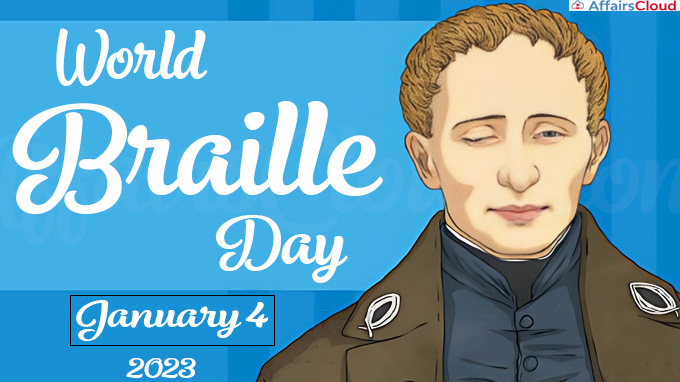 United Nations (UN)’s World Braille Day is annually observed across the globe on January 4 to highlight and raise awareness about the importance of Braille as a means of communication for the partially sighted and blind.
United Nations (UN)’s World Braille Day is annually observed across the globe on January 4 to highlight and raise awareness about the importance of Braille as a means of communication for the partially sighted and blind.
- World Braille Day commemorates the birth anniversary of Louis Braille, a 19th-century French educator, who invented Braille in 1824.
4th January 2023 marks the observance of the 5th World Braille Day and the 214th birth anniversary of Louis Braille.
Background:
i. The United Nations General Assembly (UNGA) adopted the resolution A/RES/73/161 on 17th December 2018 and declared January 4 of each year as World Braille Day.
ii. The 1st ever World Braille Day was observed on 4th January 2019.
Braille:
i. Braille is a universally accepted system of writing used by and for blind persons. It is named after its inventor Louis Braille.
ii. It consists of 63 characters made up of 1-6 raised dots arranged in a matrix or cell of 6 positions.
iii. It is beneficial for those who are blind or partially sighted to be able to read the same books and periodicals that are printed in a visual font.
Efforts of the UN:
i. In 2006, the UN adopted The Convention on the Rights of Persons with Disabilities, to advance the rights and well-being of persons with disabilities.
ii. According to Article 2 of the Convention on the Rights of Persons with Disabilities, braille is essential for social inclusion, Opinion, freedom of expression, and education.
iii. UN Disability Inclusion Strategy (UNDIS), adopted by the Secretary-General in 2019, provides the foundation for sustainable and transformative progress on disability inclusion.
About Louis Braille:
i. Louis Braille was born on 4th January 1809 in Coupvray, France. He lost his sight at the age of 3 by accidentally injuring himself.
ii. In 1821, he learned “night writing”, a tactile communication device created by French soldier Captain Charles Barbier.
iii. According to Charles Barbier’s writings, Louis Braille hoped that everyone who was unable to receive a formal education, including those with visual and auditory disabilities, might use the system.
iv. In 1824, at the age of 15, Louis Braille developed a 6-dot “cell” system. He began with Barbier’s technique and divided its 12-dot arrangement in half.
v. The system was initially published in 1829, and a complete elaboration followed in 1837.
Key Points:
i. According to the World Health Organisation(WHO), At least 2.2 billion people worldwide suffer from near or distant vision impairment. Nearly half of these cases, or at least 1 billion, involved vision damage that either might have been prevented or has yet to be addressed.
ii. The leading causes of vision impairment are age-related macular degeneration, cataract, diabetic retinopathy, glaucoma, and uncorrected refractive errors
About the United Nations (UN):
Secretary-General- António Guterres
Headquarters- New York, USA
Establishment- 1945




